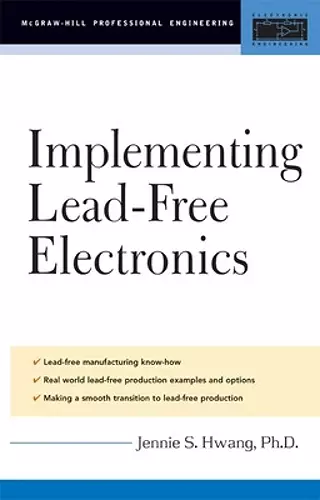Implementing Lead-Free Electronics
Format:Hardback
Publisher:McGraw-Hill Education - Europe
Published:16th Jan '05
Currently unavailable, and unfortunately no date known when it will be back

By June 2006 any company selling electronics into the European Union and China will have to convert to lead-free manufacturing processes
Virtually every electronics manufacturer in the world is faced with an expensive revamp of their operations.
This book shows them how to choose the right Lead-Free processes and make the conversion as efficiently and inexpensively as possible.
REVIEWED BY: Dr. George Riley, FlipChips Dot Com Dr. Jennie Hwang's second major book on lead-free electronics plays the ministerial role to its magisterial predecessor. It is the facilitator, carrying us from the calm of the laboratory to the clamor of the factory floor, where theories and realities collide. In the lead-free as in other worlds, implementation, not theory, ultimately determines survival. The book patterns itself on the flow of factory implementation, moving from selecting the best approach, to choosing proper materials, to controlling the soldering operation, to concerns about compatibility, costs, and reliability. The prelude is a reality check of present manufacturing practices. Here Dr. Hwang shows us how the actual conditions of use for today's eutectic lead-tin solders, rather than theoretical arguments, justify the "drop-in" approach to lead-free replacements. Present peak soldering temperatures of 230 C to 245 C are robust process parameters for printed-circuit board assembly with present surface-mount technology. Several lead-free solder formulations applicable in that temperature range promise a smooth transition to lead-free soldering, at lower costs. Manufacturing implementation follows upon a five-step evaluation. The key is recognizing the interdependence of process decisions, to insure compatibility at every stage. Solder selection summarizes some of the voluminous technical detail of Dr. Hwang's prior book, supplemented with side-by-side solder comparisons. It segues smoothly into stencil selection and solder paste application. Dr. Hwang applies an interdisciplinary headlock to embrace the physics, chemistry, metallurgy, and rheology of solder. Who would have thought that tiny little spheres could cause us so many problems? Once we are well pasted and on our way with compatible components, we are ready for the oven. Mass reflow soldering and wave soldering comprise separate chapters, again starting from a solid base of "real-world production demands." For mass reflow soldering, these include the difficulty of monitoring and controlling temperatures in a fast-moving environment. A six-pack of case studies with photographs illustrates the best practice in defect reduction. The specialty approaches of nitrogen atmosphere reflow, convection reflow, and vapor phase soldering are treated briefly, but with lead-free respect. Wave soldering is dismembered in detail. New hobgoblins here are dross, corrosion, turbulence, and compositional stability. Again, case studies tie the text to factory-based data. The specialized approaches of selective soldering and laser soldering are examined and found not wanting in lead-free suitability. Compatibility checklists remind us that no solder pot is an island. Cost simulations are presented as case studies, based upon manufacturer's models. The reliability discourse highlights the causes and cures of commonly occurring production ills. The open, bullet-point format of much of the material will make this a handy reference book, as well as a worthy supplement to its predecessor. Dr. Hwang has enlisted her long industry experience, her understanding of solder manufacturing, and her sensitivity to the concerns of students in her lead-free training courses to present an exhaustive, normative, two-volume approach to lead-free technology and implementation. Flipchips.com 20041215
ISBN: 9780071443746
Dimensions: 231mm x 158mm x 42mm
Weight: 848g
473 pages